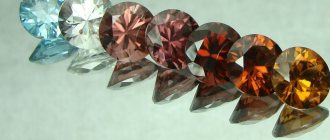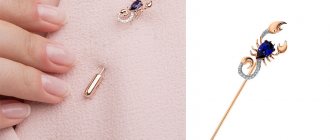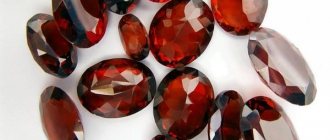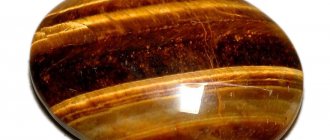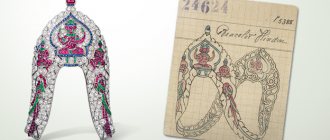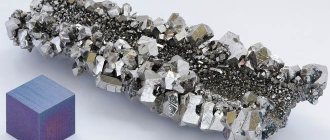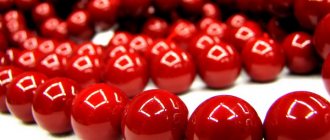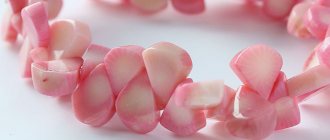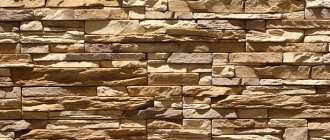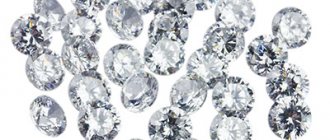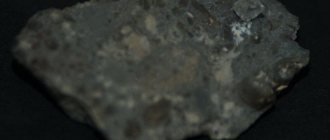The history of this element is connected with alchemy; science has taken the place of today's chemistry, albeit in a truncated form. Alchemists once counted seven metals, each of which was a symbol and sign of a specific planet. Antimony was unlucky; in the Middle Ages, not only a planet, but a tiny star was not found for it, so alchemists called antimony a semimetal. And they were not mistaken.
Modern chemists agree with alchemy on this issue; antimony cannot be called a full-fledged metal, but knowing its properties, it is difficult to distinguish this “non-metal” from full-fledged metals, so antimony - what is it and where is it used, what do they mean when they say antimony for the eyes, and Is metal safe for humans? Read about everything in the material by our author Evgeniy.
Antimony - what is this chemical element?
Antimony is an element of the periodic table with number 51. The international name is Stibium (Sb). The metallic rock is opaque, silvery-white with a bluish tint, coarse-grained and shiny. Hardness on the Mohs scale is 3-3.5.
There are two types of antimony.
- Allotropic (metals) – four options.
- Amorphous - three (antimony black, explosive, yellow).
Antimony is classified as a metalloid (semi-metal or quasi-metal) because it combines the characteristics of both groups. Some people classify antimony as a metal. In its composition, antimony is a conglomerate of two isotopes.
Isotopes
Main article: Isotopes of antimony
Natural antimony is a mixture of two isotopes: 121Sb (isotope abundance 57.36%) and 123Sb (42.64%). The only long-lived radionuclide is 125Sb with a half-life of 2.76 years; all other isotopes and isomers of antimony have a half-life not exceeding two months.
Threshold energy for reactions with the release of a neutron (first):
- 121Sb - 9.248 MeV,
- 123Sb - 8.977 MeV,
- 125Sb - 8.730 MeV.
The history of antimony is only beauty?
The history of this metal begins in the Ancient East: two thousand years BC, Egyptian fashionistas and dandies inked their eyebrows and outlined their eyelids with antimony.
The origin of the Russian term “antimony” is twofold; the meaning is a composite of the Persian “surm” and the Turkish “surm”.
An ancient antimony bowl for preparing medicinal potions
In the Ottoman Empire, this was the name given to the metal powder galena, which the Turks used to ink their eyebrows. The Persians designated each metal with the word “surm”.
The term antimony was used back in the Middle Ages, and at the end of the 18th century, Antoine Lavoisier, the “luminary” of European science, introduced it into scientific circulation and into the list of known chemical elements.
However, the first European to experiment with antimony, two hundred years earlier, was the famous German alchemist Basil Valentin. He described the properties and methods of obtaining this substance.
Historical reference
Antimony has been known since ancient times. In the countries of the East it was used approximately 3000 BC. e. for making vessels. In Ancient Egypt already in the 19th century. BC e. Antimony luster powder (natural Sb2S3) called mesten
or
stem
was used to blacken eyebrows.
In Ancient Greece it was known as stími
and
stíbi
, hence the Latin
stibium
.
Around 12th-14th centuries. n. e. antimonium
appeared .
In 1789, A. Lavoisier included antimony in the list of chemical elements called antimoine
(modern English
antimony
, Spanish and Italian
antimonio
, German
Antimon
).
Russian "antimony" comes from the Turkish sürme;
it denoted the lead glitter powder PbS, which was also used for blackening eyebrows (according to other sources, “antimony” is from the Persian “surme” - metal). A detailed description of the properties and methods of obtaining antimony and its compounds was first given by the alchemist Vasily Valentin (Germany) in 1604.
Physical and chemical properties of antimony
Natural metallic (gray) antimony combines the properties of a metal and a non-metal.
- A gray antimony nugget is hard and shiny, like metal.
- However, it is a brittle metal and can be easily crushed in a mortar and regular mortar.
- The substance is a low-power electrical and thermal conductor.
- When cooled, antimony expands.
- The modification properties of this substance are interesting:
- Yellow antimony becomes a semiconductor when heated or exposed to bright sunlight.
- Explosives detonate when exposed to heat or friction.
- Under standard conditions, the substance is chemically stable and oxidizes at 600 °C.
- Reacts with concentrated nitric and sulfuric acid, halogens; antimony dissolves in "aqua regia".
Antimony deposits in Russia and the world
Geology today lists 75 antimony-bearing minerals, of which stibnite is the most common in primary ores.
Deposits are divided into 4 types depending on the content of the antimony mineral:
- Unique, more than 100,000 tons.
- Large - 30-100 thousand tons.
- Average - 10-30 thousand tons.
- Small pool - up to 10 thousand tons.
Significant deposits of this mineral have: China (Xinguanshan - unique), Russia (Sarylakh and Sentachan in Yakutia, Razdolninskoye and Udereyskoye in the Krasnoyarsk Territory), Bolivia (Chilkobia), Kyrgyzstan (Kadamzhai, Khaidarkan) Mexico (San Jose), South Africa (Gravelot - unique), Tajikistan (Anzob) and Thailand (Bonsong).
Production
Native antimony exists, but it is not of industrial interest.
There are more than a hundred antimony ores in nature, but the richest is stibnite (more than 60% of the ore-forming element).
Countries with the largest antimony deposits:
- China;
- Tajikistan;
- SOUTH AFRICA;
- Bolivia;
- Mexico.
Russia has the second place in the world in the extraction and production of antimony concentrates.
Antimony - where it is used
The lion's share of antimony products is used in industry and the defense sector. Today, more than two hundred alloys are known that contain antimony.
From the 15th century to the present day, the most famous Hart alloy (lead + antimony + tin) has been used in printing. It is also used in the production of pipes for aggressive (acid, alkali) liquids.
Antimony sulfides are used to vulcanize rubber, make matches, and produce very durable (flexible and heat-resistant) red medical rubber.
Electronics
Almost all of the resulting raw materials (up to 15% Sb in the alloy) are collected by manufacturers of batteries and accumulators. The metal is used to make cable braids, electrodes, and radiation shielding surfaces.
Today, neither electronics, nor computers, nor “smart” automotive equipment, nor equipment for mining farms work without semiconductors. All semiconductors use alloys of antimony with aluminum, rare earth and other similar metals (germanium, indium, gallium). Antimony sulfides are used in chemical and other industries:
- rubber vulcanization;
- fluorescent lamps;
- medicine (heat-resistant elastic rubber, medicines);
- solution for textile production.
Antimony is found in sparklers, fireworks, other pyrotechnics and matches.
Fine antimony powder is the basis of paints (“iron black”) used by artists.
Does eye antimony have contraindications and side effects after use?
Like any other product, kajal for eyes has a number of contraindications. If it is applied incorrectly or purchased low-quality antimony, women risk facing undesirable negative consequences.
So, these are considered contraindications.
- Infancy. Despite the fact that in the East it is customary to paint a newborn’s eyes immediately on the first day of his life, it is still better to abandon this idea. Children have too delicate skin and underdeveloped eye muscles. Contact with an aggressive dye will negatively affect vision and light perception.
- Postoperative period. Antimony should not be used for a month or two after eye surgery. It doesn't matter that it was done using the latest technology. If paint gets on the membrane of an unhealed eye, it can cause, for example, rejection of the restored lens during cataract treatment.
- Cuperosis in the eye and eyelid area.
- Daily wearing of contact lenses.
- Allergic reactions to product components.
It is recommended to carefully select antimony: if the composition is not described on the packaging, then you should at least pay attention to the production date. It is appropriate to study information about the manufacturing company in advance and read reviews. It is better to give preference to kajal made from almond, olive, and camphor oils.
The fact that pencil or paint is not suitable for you is evidenced by such manifestations as the development of conjunctivitis, blepharitis, swelling, irritation, redness of the eyelids and mucous membrane of the eye, and deterioration of vision.
Removing antimony from solution
To extract antimony from the resulting solution, the sulfide electrolysis method is used, which is carried out in steel baths with anodes and cathodes made of smooth plates, also made of steel.
Microdoses of the substance (0.00001% by weight) are present in living organisms, but the element itself, especially trivalent and its derivatives, is poisonous.
Antimony can accumulate in the body, suppressing the functioning of the thyroid gland (a goiter appears) and the genital area. Antimony and its compounds are classified as chemically hazardous substances of class 2.
The content of the substance in the surrounding atmosphere is regulated by sanitary standards. Maximum permissible concentrations (mg):
- Air - 0.01 (m³);
- Soil - 4.5 (kg);
- Drinking water - 0.005 (l);
- Natural water - 0.05 (l);
- Industrial wastewater - 0.2 (l).
Workers in mining and metallurgical companies are at risk; Antimony "foundry fever" is a major occupational disease among workers in the metallurgical industry, who can be poisoned by antimony fumes and dust.
Symptoms of damage: irritation of the respiratory system, eyes, skin, nosebleeds.
Once in the digestive tract, antimony becomes a less harmful metal, since during the digestion process it goes through a stage of hydrolysis, after which it is excreted from the body.
The lethal dose of antimony is 100 mg for an adult and half that for a child.
Medicine
For medicinal purposes, colorless antimony is used for the eyes. It is difficult to find reviews from doctors about its unconventional use, since doctors are usually reserved in comments related to traditional methods of treatment. However, there are no obvious contraindications or excuses either.
To enhance the therapeutic effect, camphor, oils or herbs are added to antimony. Thus, the first substance has a cooling and refreshing effect, causing lacrimation and some discomfort in the eyes during the first use. But when the victim of beauty blinks and is able to open her eyes, her gaze takes on a clear and healthy appearance without an iota of fatigue. Adding oils has a positive effect on eyelash growth and moisturizing the skin around the eyes. Basma and herbal extracts nourish the epidermis. They are also great for eyelashes and eyebrows.
Medicinal antimony helps in the following cases:
- Treats eye infections: conjunctivitis, stye.
- Used against seasonal allergic eye irritation.
- Relieves visual fatigue.
- Improves blood circulation in the eyeball, strengthening the vascular network.
- Makes vision sharper and clearer.
- Accelerates the growth of eyelashes and eyebrows.
If a fashionista wears contact lenses and suffers from allergies to cosmetics, then antimony can be an excellent alternative to decorative cosmetics.
Why do we need antimony?
Metallic antimony is rarely used due to its brittleness, but since antimony increases the hardness of other metals (tin, lead) and does not oxidize under normal conditions, metallurgists often introduce it into various alloys. The number of alloys that contain element No. 51 is about two hundred; The most famous antimony alloys are solid lead (or heartbley), printing metal, and bearing metals.
The supporting metals are alloys of antimony with tin, lead and copper, to which zinc and bismuth are sometimes added. These alloys melt relatively easily and are used to cast bearing shells. The most common alloys in this group, babbitts, contain from 4 to 15 percent antimony. Babbitts are used in mechanical engineering and tool production, railway and automobile transport; bearing metals have sufficient hardness, high wear resistance, and high corrosion resistance.
The sulfur head of a match contains antimony
Antimony is one of the few metals that expands when solidified, and due to this property of antimony, the metal type (an alloy of lead (82%), tin (3%) and antimony (15%)) fills writing molds well, and lines cast from this metal gives well-defined strokes. Antimony gives the metal hardness, impact resistance and abrasion resistance.
Lead doped with antimony (5 to 15%) is known as hartley, or hard lead. Adding just 1% Sb to lead greatly increases its hardness; solid lead is used in chemical engineering and for the manufacture of pipes through which aggressive liquids are transported. It is also used to make telegraph, telephone and electrical cable sheaths, electrodes and battery plates. The latter, by the way, is one of the main uses of element 51. Antimony is also added to lead, which is used in the manufacture of shrapnel and projectiles.
Application
Antimony is increasingly used in the semiconductor industry in the production of diodes, infrared detectors, and Hall effect devices. In the form of an alloy, this metalloid significantly increases the hardness and mechanical strength of lead. Used:
- batteries - antifriction alloys - printing alloys - small arms and tracer bullets - cable jackets - matches - medicines, antiprotozoals - soldering individual lead-free solders contain 5% Sb - use in linotype printing machines
Antimony compounds in the form of oxides, sulfides, sodium antimonate and antimony trichloride are used in the production of refractory compounds, ceramic enamels, glass, paints and ceramic products. Antimony trioxide is the most important of the antimony compounds and is primarily used in flame retardant compositions. Antimony sulfide is one of the ingredients in match heads.
A naturally occurring antimony sulfide, stibnite, was used in biblical times in medicine and cosmetics. Stibnite is still used as a medicine in some developing countries. Antimony compounds—meglumine antimoniate (glucantim) and sodium stibogluconate (pentostam)—are used in the treatment of leishmaniasis.
Physical properties
Ordinary antimony
It is a silvery-white metal with a strong shine. Unlike most other metals, it expands when it solidifies. Sb lowers the melting and crystallization points of lead, and the alloy itself expands somewhat in volume upon hardening. Together with tin and copper, antimony forms a metal alloy - Babbitt, which has anti-friction properties (use in bearings). Sb is also added to metals intended for thin castings.
Electronics
Included in some solders
Nuclear energy, nuclear weapons
Some isotopes of antimony are important in nuclear technology, and in particular in nuclear weapons technology, mercury pyroantimonate (oxystibate) with the corresponding isotopic composition (which largely contributed to the spread of legends about the so-called “red mercury.” The peculiarity of this substance is that it is a kind of multifunctional nuclear catalyst (neutron multiplication factor 7-9) and should be taken very strictly into account by any country in view of the threat of nuclear terrorism.
Prices
Prices for antimony metal in ingots with a purity of 99% were about $5.5/kg.
Thermoelectric materials
Antimony telluride is used as a component of thermoelectric alloys (thermo-emf with 100-150 μV/K) with bismuth telluride.
Wherever there is sun
Although the content of antimony in the earth's crust is very small, traces of it are found in many minerals. Sometimes antimony is found in meteorites, sea water, some rivers and streams also contain antimony, but antimony lines are not found in the spectrum of the Sun.
Antimony and paints, many antimony compounds can serve as pigments in paints, for example, antimony-alkali potassium (K20 - 2Sb205) is widely used in the production of ceramics. Sodium stibium sulfate (NaSb03), called leuconine, is used to coat kitchenware and in the production of enamel and white milk glass.
Antimony Ingot
The famous paint “Neapolitan yellow” is nothing more than antimony-lead oxide. Used in painting as an oil paint, as well as for ceramics and porcelain. Even metallic antimony, in the form of a very fine powder, is used as a paint. This powder is the basis of the famous iron yellow paint.
“In 1974, N.N. Lyalikova, a Soviet microbiologist, discovered a previously unknown antimony bacterium that feeds exclusively on antimony trioxide Sb203. It oxidizes trivalent antimony to pentavalent antimony, and many naturally occurring pentavalent antimony compounds are thought to have been formed by "antimony" bacteria.
Antimony as a mineral: mining and production
Deposits of metallic antimony are located in South Africa, China, Algeria, Russia, Bulgaria, Azerbaijan, Kyrgyzstan, Serbia, Finland, Kazakhstan, and Tajikistan. The content of the element in the earth's crust is low - 500 mg/t. Most of the substance is concentrated in sedimentary rocks - bauxite, phosphorite, and shales. The least fossils are found in sandstones and limestones.
More than 70% of this metal is produced in China, and the remaining 30% is shared by Russia, Myanmar, Bolivia, Tajikistan, South Africa, Canada, Australia and some other countries.
China also has the largest reserves - more than 50% of the world's reserves. About 20% is located in Russia, 16% in Bolivia, 3% in Tajikistan, 1% in South Africa, less than 10% is dispersed across different countries.
Biological role of antimony and effect on the body
Antimony is toxic, it belongs to toxic biological microelements, its content in the human body is 1-6%. Antimony in compounds is constantly present in living organisms; the physiological and biochemical role of such a dangerous element is still not clear to scientists.
Antimony exhibits an irritating and cumulative effect, it accumulates in the thyroid gland, suppresses its function and causes endemic goiter, however, when entering the gastrointestinal tract, antimony compounds do not cause poisoning, since Sb (III) salts are hydrolyzed there to form water-insoluble products .
At the same time, antimony (III) compounds are more toxic than antimony (V) compounds. Dust and fumes of Sb cause nosebleeds, antimony “lithium fever”, atherosclerosis of the lungs, affect the skin, and disrupt sexual function. Taste threshold in water - 0.5 mg/l, Lethal dose for adults - 100 mg, for children - 49 mg, for antimony aerosols MPC in the air of the working area 0.5 mg/m3, in ambient air 0.01 mg/m3 .
Let's look deeper into etymology
In different languages, the same means has variations in names. When they say “kohl”, “kajal” (or “kujal”), “kayal”, they mean the same antimony. This word translated from Turkish means “blackening”. This applies to eyelashes and eyebrows. Other variations change their meaning somewhat. Thus, “kayal” from the ancient Assyro-Babylonian language is translated differently - “cosmetics”. The word “kajal” is most often used in relation to a soft antimony pencil. And when making antimony from coal, called black stone or kohl, a similar name is transferred to the eye product itself.
